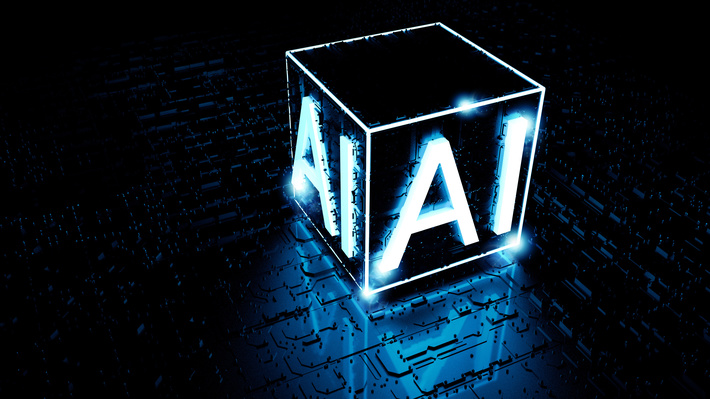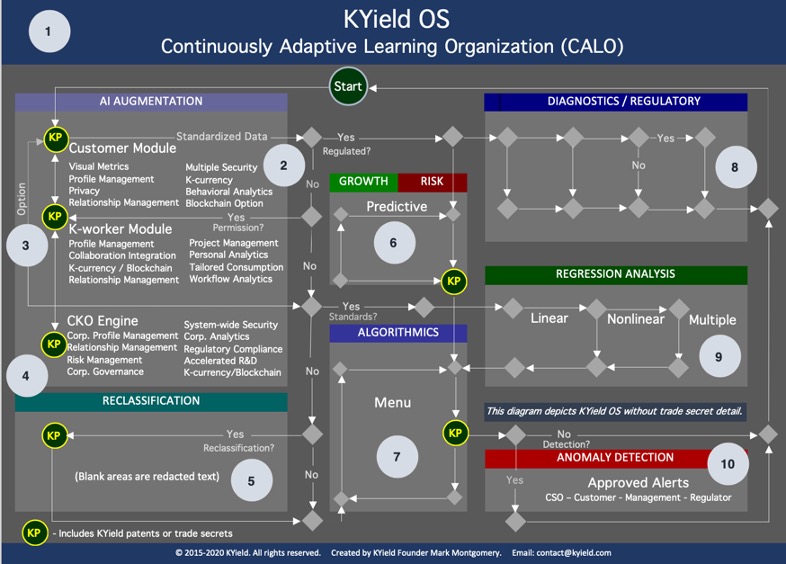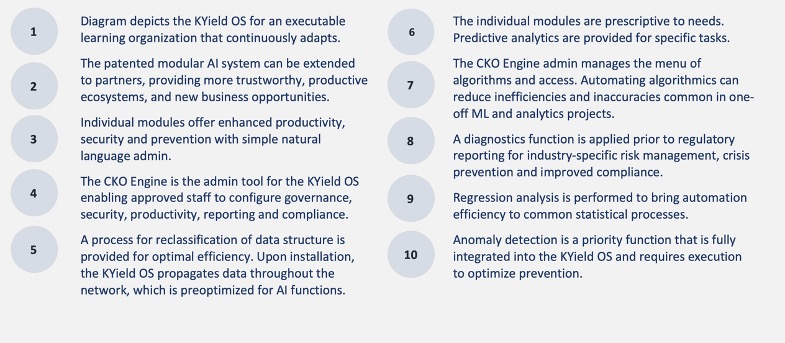
Build a Continuously Adaptive Learning Organization (CALO)
Among the most perplexing challenges facing CEOs in recent years is how best to compete in a data-driven economy that is becoming increasingly dominated by large and rapidly growing companies, often described as superstar firms. Although the most valuable superstar firms are in the technology industry, the group includes hundreds of corporations in other industries that have grown rapidly during globalization.
Over the course of several dozen discussions with superstar firms and their competitors, unique characteristics in each company have become apparent, as have commonalities. The combination of vast customer bases, increasingly intelligent enterprises, large-scale supply chains, top-tier teams that include the majority of leading AI scientists, and comparatively infinite capital make superstar firms formidable opponents. It is unsurprising then that business owners and managers in the path of superstar firms express concerns about their daunting future. One common growth strategy in superstar firms is to leverage strengths to enter new industries, which causes considerable risk for companies of all sizes.
Opportunities for competitors of superstars exist nonetheless. In order to continue to grow at the same pace over the next decade, the fastest growing superstars would need to rapidly expand in other large industries, such as finance and education, which are highly regulated industries, or healthcare, which are government monopolies in much of the world. Amazons revenue, for example, grew by over $105 billion in 2020. Revenue growth for the group of superstars we track exceeded $1 trillion in 2020.
The rapid growth and market power of superstars causes complex challenges for society and governments, leading to increased antitrust enforcement, fines, and increased regulation. The reactions by markets and regulators is the primary reason why superstars in one business cycle are knocked out of the top decile by the next business cycle, which was confirmed by McKinsey & Companys research on superstar firms. Given these headwinds, it will become increasingly difficult for superstar firms to maintain a similar growth rate moving forward, providing an opportunity for competitors. In addition, tens of billions of dollars of investment in AI research and development over the last decade has resulted in sharply lower cost of adoption with much higher performance levels, opening the option for most organizations to adopt advanced AI systems.
Evolution from a Learning Organizations to a CALO
In 1987, Peter Senge and his team argued that if leaders could build learning organizations that shared knowledge, collectively learned, and adapted to changing conditions, the organization would significantly increase probabilities of success. Todays superstar firms are modern versions of learning organizations that aggressively apply this concept across their networked enterprise. Given the volume of internal and external information in the network economy, the ability to learn, adapt and execute requires sophisticated data management systems. We describe modern versions of these organizations as Continuously Adaptive Learning Organizations, or CALOs.
One example of a CALO is Amazon and their AWS division. The worlds largest ecommerce retailer learned valuable lessons from its online operations, leading to the creation of AWS, which provided Amazon a superior business model that delivered about 90 percent of the companys cash flow in 2020. Another example is NVIDIA, which invented the graphics processing unit (GPU) in 1999. In 2012, AlexNet won the ImageNet competition, leading to the use of GPUs and convolutional neural networks. NVIDIA has since adapted by seizing the opportunity in machine learning to overtake Intel as the most valuable semiconductor company.
In the parcel delivery business, UPS learned from decades of operations research, resulting in a route-optimization program ORION that saves the company hundreds of millions of dollars annually while reducing 100,000 metric tons of greenhouse gas emissions every year.
Walmart learned from fierce competition with Amazon and other e-commerce leaders that they needed a new operating system (OS). Walmart reacted by making a bold decision to invest $3.3 billion to acquire Jet.com, providing a key ecommerce component to Walmarts new type of OS. Four years later ecommerce sales at Walmart surpassed $40 billion annually and the company produced a $5 billion quarterly profit.
Although each of these companies represent a different type of CALO, they all demonstrated the ability to learn and adapt to highly complex, rapidly changing conditions in the network economy. These companies made significant investments in technology, adapted within the competitive time window and seized opportunities. Management in CALOs must master systems thinking, which is the fifth discipline in Peter Senges book by the same name. Achieving a CALO today requires management to view their organizations as complex adaptive systems, increasingly enhanced with AI.
While no organization has achieved a perfect CALO, some are clearly much closer than others. If it were possible to access sufficient data to create a CALO index across the public and private sectors, our engagements suggest that the highest performing superstars would achieve somewhere around 80% of a perfect CALO, and the lowest performing organizations would be about 10%.
Some organizations lack external incentives to learn and adapt, while others face hypercompetitive environments that require a functional CALO to survive. Superstars enjoy a combination of scale, talent, and technology, all unified within a networked enterprise and interconnected with their global ecosystem. Those organizations lacking a competitive enterprise should assemble components through partnerships, scale, talent and technology.
New innovations and business models can also be effective. Costco, for example, is among the most successful superstar firms in the retail industry. The company manages a large global supply chain and sophisticated interconnected enterprise, yet isnt known for technology or ecommerce. To date Costco has performed well even as its competitor Amazon has grown much larger. Tesla provides an interesting case of a new company that pioneered new products in electric vehicles to become a superstar, despite entrenched competition and an exceptionally high cost of entry.
These and many other successful companies owe their success in part to achieving a functional CALO. Given the entrance of enterprise-wide AI systems with the capacity to quickly learn, the bar is rapidly rising. The majority of organizations will therefore need to substantially increase the functionality of their CALO, including superstar firms, as AI-enhanced competitors rapidly learn and adapt.
Powering the CALO with AI Systems
Although low-cost commoditized computing is necessary, ubiquity has a very high cost it provides no competitive advantage. This IT commoditization paradox favors superstar firms with sufficient scale, wealth, and talent to compete in advanced technology. Superstar firms typically invest heavily in custom systems and applications to remain competitive. An alternative approach is to adopt an enterprise-wide data management system pre-designed to optimize machine learning, which can provide some of the advantages of custom software without the high cost of custom AI systems. Precision data structure tailored to the needs of each entity can leverage and augment human capital in the organization, which is ultimately the most important competitive advantage all others depend on.
Principled Management for Enterprise AI
We recently disclosed our 15 enterprise AI management principles, providing brief rationale and implications for each, which can serve as a management guide for enterprise AI (EAI) systems. In the AI era, the implications of planning and execution are profound. Even those organizations historically protected by market dominance or legislation are at risk. Whether businesses or nations, those who fall behind may not be in a position to honor their full obligations in the future.
Principle 1: EAI should have governance, ethics, and security built-in from inception.
Rationale: Good system design is paramount. Governance is the foundation AI systems are built upon.
Implications: Attempting to add-on governance, ethics, and security after the fact is technically difficult, inefficient, and prone to error.
Principle 2: Design-in systemic data quality management.
Rationale: AI systems are only as good as the data they train on.
Implications: Garbage-in / garbage-out; quality-in / quality-out.
Principle 3: Maintain strong security.
Rationale: EAI includes the most important human workflow in the enterprise, including strategy, planning, and intellectual property.
Implications: Compromised EAI systems can be devastating to the organization.
Principle 4: Embed integrity throughout AI systems.
Rationale: Enterprise-wide AI systems interacts with the entire organization, providing a foundation for integrity.
Implications: If EAI systems lack integrity, so too will the organization.
Principle 5: Maintain objectivity.
Rationale: AI systems are an invitation for manipulation from political activists, fraud, and governments with totalitarian tendencies, resulting in misinformation that can lead to a dystopian future. Unless prevented, unconscious bias can also become embedded in AI through human workflow and algorithms.
Implications: Maintaining objectivity in EAI is essential. Cognitive bias is a significant risk in AI systems that has already been realized at scale.
Principle 6: Provide privacy, transparency and explainability.
Rationale: In order to earn and maintain trust, EAI systems should be transparent and explainable in a simple manner.
Implications: If employees, customers, and partners dont trust the system, they are less likely to participate and/or attempt to work around the system.
Principle 7: Empower individuals.
Rationale: Organizations of every size and type consist of individuals.
Implications: Organizations that lose sight of the needs of individuals tend to experience low morale, high turn-over, and cultural deterioration.
Principle 8: Adopt enterprise-wide architecture.
Rationale: Value sometimes arises where least expected.
Implications: The one individual or sensor left out of EAI for the enterprise, supply chain, or ecosystem might be the one that recognized and alerted an existential risk.
Principle 9: Turbocharge prevention with EAI.
Rationale: The highest ROI possible is prevention of major crises.
Implications: Failure to prevent crises can lead to a negative spiral, failure, and collapse.
Principle 10: Accelerate discovery and productivity.
Rationale: Well-designed AI systems have a unique capacity to augment, enhance, and accelerate discovery, research, development, and execution.
Implications: It may not be possible to catch competitors that are more effective in applying EAI for productivity growth and R&D.
Principle 11: Establish and maintain a competitive advantage.
Rationale: AI systems learn quickly, innovation is accelerating, and the gap between AI leaders and laggards is rapidly expanding.
Implications: Organizations that fail to maintain competitive AI systems are at high-risk of falling behind, disruption, and displacement.
Principle 12: Leverage EAI for continuous human learning and improved decision making.
Rationale: Rapid machine learning only becomes an advantage when it improves human behavior.
Implications: Failing to rapidly learn in the AI era risks extinction.
Principle 13: Mitigate risk in development, auditing, and monitoring EAI.
Rationale: How and who designs, audits, and monitors AI systems can determine the outcome.
Implications: A significant percentage of large enterprise crises have been due to internal actors (dont try this at home).
Principle 14: Incentivize accuracy and improvement with knowledge currency.
Rationale: Data intelligence within the system allows more accurate financial and psychological rewards with digital currency, which can serve to guide organizational and individual behavior.
Implications: Organizations that fail to recognize and reward top performers tend to lose them to competitors.
Principle 15: Continuously adapt.
Rationale: The species that survives is the one that is able best to adapt and adjust to the changing environment in which it finds itself. Charles Darwin, The Origin of Species.
Implications: The pace of change appears to be accelerating. Organizational cultures that master AI systems for continuous adaptation are most likely to thrive in the future.
Balancing Ethics with Existential Risk
Organizations are faced with difficult strategic and ethical choices in the era of AI. At one extreme, governments from all over the world are currently faced with the decision of whether to allow their military to employ automated weapons at large scale. The rationale and implications for senior military officers are relatively simple ethical considerations are not. Is it more ethical to embrace banning automated weapons given difficulties of enforcement and risk to nations, or authorize automated weapons and focus on precision governance?
Business leaders are faced with similar existential questions and must balance ethics with fiduciary responsibilities and perhaps even survival. Although most businesses are not yet faced with immediate extinction, strategic decisions on AI can have profound impacts. Machine learning is rapid and begins immediately upon adoption, providing an incentive to make bold investments early in the process of commercialization, yet some companies that jumped in early have wasted billions of dollars. Many other companies have experimented with machine learning projects rather than embarking on a bold journey in AI systems, just to learn that a systems approach is necessary to be competitive.
Regardless of size or type of organization, leaders will need to balance ethics with performance and strategic imperatives in the AI era. Otherwise, their organizations may not survive long enough to make future positive impacts for shareholders, employees, customers and society. In our many discussions with leaders surrounding enterprise AI systems, although a variety of different strategies have been executed and many mistakes made, the highest performers demonstrated the ability to quickly learn and adapt. Whether organizations have ambitions to become a superstar firm or must defend against them, the goal should be to first achieve a CALO enhanced with AI.
References
[1] The Rise of Superstars, The Economist, Special Report, September 17th, 2016. www.economist.com
[2] M. Bajgar, S. Calligaris, C. Criscuolo, l. Marcolin, and J. Timmis Superstars Are Running Away With The Global Economy, Harvard Business Review, November 14, 2019. https://hbr.org
[3] D. Autor, D. Dorn, L. Katz, C. Patterson, J.V. Reenan, The Fall of the Labor Share and Rise of Superstar Firms, Quarterly Journal of Economics 135, no. 2 (May 2020): 645709.
[4] J. Manyika, S. Ramaswamy, J. Bughin, J. Woetzel, M. Birshan and Z. Nagpal, Superstars: The dynamics of firms, sectors, and cities leading the global economy, McKinsey Global Institute, October 24, 2018, www.mckinsey.com.
[5] R. Heston and R. Zwetsoot, Mapping U.S. Multinationals Global AI R&D Activity, Center for Security and Emerging Technology, December, 2020. https://cset.georgetown.edu
[6] P. Senge, The Leaders New Work: Building Learning Organizations, MIT Sloan Management Review, October 15, 1990. https://sloanreview.mit.edu
[7] S. Rosenbush, L. Stevens, At UPS, the Algorithm is the Driver, The Wall Street Journal, February 16, 2015. https://www.wsj.com
[8] M. Montgomery, KYield, Why Every Company Needs a New Type of Operating System Enhanced with AI, September 10, 2017. https://kyieldos.com
[9] The Fifth Discipline: The Art and Practice of the Learning Organization, P. Senge (New York: Doubleday Currency, 1990).
[10] J. S. Lansing, Complex Adaptive Systems, Annual Review of Anthropology, no. 32 (October, 2003): 183-2004
[10][10] J. Dastin, P. Dave, U.S. commission cites ‘moral imperative’ to explore AI weapons, Reuters, January 26, 2021. https://www.reuters.com
[12] T. Levin, One of Ubers earliest investors says the billions it spent on self-driving were a waste of money, Business Insider, February 2, 2021. https://www.businessinsider.com
[13] B. Ghosh, P. R. Daugherty, H. J. Wilson, and A. Burden, Taking a Systems Approach to Adopting AI HBR, May 9, 2019. https://hbr.org


